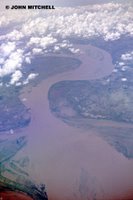I recently had a chat with geographer and author Tony Burton about his latest book Mexican Kaleidoscope: myths, mysteries, and mystique (Sombrero Books, 2016, 165 pages), a wide-ranging collection of informative and often surprising vignettes gathered from Mexico's rich history and culture. Tony's unique book brings to light many little-known facts about this fascinating country and its people. A copy belongs on the bookshelf of every serious Mexicophile.

JM: You have been writing about Mexico for many years, what first got you interested in the country?
Tony: Necessity! I was teaching geography in the Caribbean and the examination syllabus required a study of Mexico. The Mexican chapters in Robert West and John P. Augelli's wonderful book Middle America: Its Lands and Peoples were familiar friends by the time I spent the summer of 1977 touring the southern half of Mexico. Two years later, I returned to teach geography in Mexico City. The complexity of Mexico's geography kept me hooked, which is why I jumped at the opportunity a few years ago to collaborate with Dr. Richard Rhoda to write Geo-Mexico, the Geography and Dynamics of Modern Mexico. Amazingly, that book (published to coincide with Mexico's bicentenary celebrations in 2010) turned out to be the first ever English-language, college-level book devoted to Mexico's geography. (For more details, see geo-mexico.com)
JM: What prompted you to write Mexican Kaleidoscope?
Tony: I'd been planning to write a book along these lines for a number of years but only got sufficiently organized to carry through on the plan last year! One of my main motivations was that (to the best of my knowledge) no similar book for the general reader had been published in the past forty years. An incredible amount of interesting academic research has been done on Mexico over that time, leading to reevaluations and reinterpretations of many former ideas and beliefs. I wanted to make readers aware of some of these extraordinary developments, which continually refuel my passionate interest in Mexico.
JM: How did you come up with the title?
Tony: The title Mexican Kaleidoscope is a nod to a British writer, Norman Pelham Wright, whose own collection of essays, with the same title, was published in 1948. That book was an eye-opener for me when I first began to get intimately acquainted with Mexico more than forty years ago. The subtitle Myths, Mysteries and Mystique came from a suggestion by one of my regular golfing partners (who had read an early draft of the book) as we played the 11th hole at Cottonwood Golf Course.
JM: A lot of research must have gone into this book. How long did it take you to write it? What were some of the challenges?
Tony: The research was done sporadically over more than twenty years, in conjunction with other writing projects. The main challenge was that because Mexico is such a fascinating country it was hard to decide what to include and what to omit!
JM: Mexican Kaleidoscope has 30 chapters. Which ones are your favorites? Why?
Tony: That's a great question, but actually I prefer not to answer since I hope readers will find and enjoy their own favorites. What I can say is that each and every chapter has come to mean far more to me than is expressed by mere words on a page. I really hope some of my enthusiasm comes through to readers.
JM: The book is illustrated by Mexican artist Enrique Velázquez. What do you think his drawings add to the text?
Tony: I've known Enrique and his family for many, many years. He has a keen interest in the subject matter and an uncanny ability to portray ideas in just a few lines. I originally envisioned using small, inline drawings to break up the text, much in the manner of old-time illustrators, but his final drawings were far too good for that, so we changed track and gave them the prominence and space they merit.
JM: What do you hope readers will take away from Mexican Kaleidoscope?
Tony: That's a tough question since I think it depends on what readers bring to the process. At the very least I'd like the book to cause readers to stop and think, to be occasionally surprised, and perhaps question things that they may have previously thought or heard about Mexico. As I've written elsewhere, Mexico is not always an easy country to understand but any effort to do so always seems to bring rich reward!
JM: Do you have any other books about Mexico in the works?
Tony: Yes. I'm hoping to complete a companion volume to Mexican Kaleidoscope by the second half of this year. Whereas Mexican Kaleidoscope focuses primarily on history and culture, the next book (title still under wraps) focuses on Mexico’s astonishingly varied natural history (flora and fauna) and its cultural connections. I'm also actively researching material for books about the twentieth century history of the Lake Chapala region, and about the development of that area's literary and artistic community. For that last project, I've begun publishing short profiles of some of the key players at sombrerobooks.com.
JM: How can Mexico Premiere fans order a copy of Mexican Kaleidoscope?
Tony: Both print and Kindle editions of Mexican Kaleidoscope are available via all Amazon sites - amazon.com, amazon.ca, etc. There are also ebook versions for Kobo and other ereaders via iTunes, Barnes & Noble and Smashwords. Readers in the Lake Chapala area can find the book in local stores such as La Nueva Posada, Diane Pearl Collections, Mi México and in Enrique Velázquez's art gallery. I also have a limited number of copies that can be signed and personally dedicated for Mexico Premiere fans if they contact me via sales@sombrerobooks.com
PREVIOUS BOOKS BY TONY BURTON
Western Mexico, A Traveler's Treasury (4th edition)
Chapala Through the Ages; an anthology of travellers' tales (2008)
Co-author of Geo-Mexico, the geography and dynamics of modern Mexico


